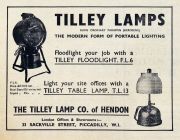Tilley Lamp Co: Difference between revisions
No edit summary |
No edit summary |
||
| Line 34: | Line 34: | ||
1915 The Tilley High-Pressure Gas company moved to Brent Street in Hendon and started work with paraffin (kerosene) as a fuel for the lamps. | 1915 The Tilley High-Pressure Gas company moved to Brent Street in Hendon and started work with paraffin (kerosene) as a fuel for the lamps. | ||
During World War I | During World War I Tilley's lamps were widely used in the British armed forces. | ||
1920 The company started making the lamp that made its name famous<ref>[http://tilleylamp.co.uk/about_us] Tilley company website</ref>. It became so popular that ''Tilley'' became used as a generic name for a kerosene lamp in many parts of the world, in much the same way as ''Hoover'' is for vacuum cleaners. | 1920 The company started making the lamp that made its name famous<ref>[http://tilleylamp.co.uk/about_us] Tilley company website</ref>. It became so popular that ''Tilley'' became used as a generic name for a kerosene lamp in many parts of the world, in much the same way as ''Hoover'' is for vacuum cleaners. | ||
Revision as of 10:45, 21 July 2017


















of Colindale Avenue, London; of 33 Sackville Street, Piccadilly, W.I. (1947); of 15 Sackville Street, London, W1 (1951)
The Tilley Lamp derives from John Tilley’s invention of the hydro-pneumatic blowpipe in 1813.
1818 W. H. Tilley began manufacturing pressure lamps at the works in Stoke Newington, and in Shoreditch in the 1830s.
His son, William H. Tilley, was a successful gas fitter and plumber in Shoreditch, the business known as W. H. Tilley
William's sons, Frederick and William, worked in the business and took it over after their father's death.
By 1909 the business had become Tilley Brothers[1]
1909 The Tilley High-Pressure Gas Syndicate Ltd. was incorporated as a Private company[2] by Frederick Charles Tilley, William Henry Tilley and others [3] to manufacture high pressure gas lighting equipment using coal gas that had been developed by Frederick.
1915 The Tilley High-Pressure Gas company moved to Brent Street in Hendon and started work with paraffin (kerosene) as a fuel for the lamps.
During World War I Tilley's lamps were widely used in the British armed forces.
1920 The company started making the lamp that made its name famous[4]. It became so popular that Tilley became used as a generic name for a kerosene lamp in many parts of the world, in much the same way as Hoover is for vacuum cleaners.
During the 1920s the company had diversified into domestic lamps, and had expanded rapidly after orders from a number of railway companies.
Name changed - the Tilley Lamp Co had been established by 1924 (see advert)
1937 Portable lamps, floodlights and searchlight projectors. "Tilley" Lamps. [5]
After the World War II fears about the poisonous effect of paraffin fumes, and freely available electricity reduced demand for domestic use.
1947 Name changed.
1949 Company made public.
1959 The company began diversification[6]
1961 The company moved its operations from Hendon to Ireland, finally settling in Belfast.
1961 Manufacturers of "Tilley" paraffin vapour lamps, radiators and low pressure gas appliances. 360 employees. [7]
1970 Merger with Falks Veritas[8] but failed on concern about US liability issues.
By 1989 the company was an unquoted subsidiary of Candlewood Holdings
In 2000 they relocated.
See Also
Sources of Information
- [2] Wikipedia

